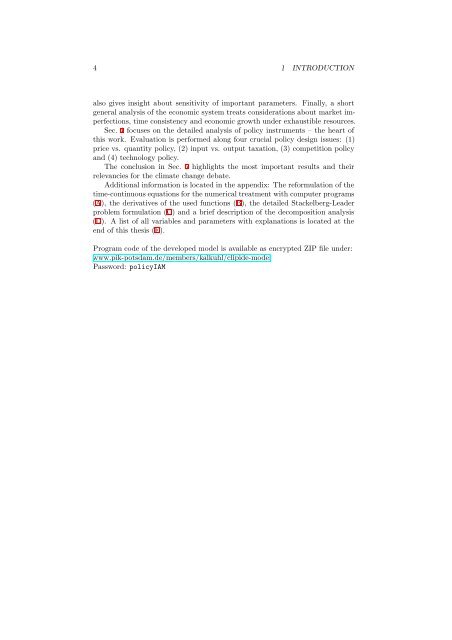Modeling Climate Policy Instruments in a Stackelberg Game with ...
Modeling Climate Policy Instruments in a Stackelberg Game with ...
Modeling Climate Policy Instruments in a Stackelberg Game with ...
You also want an ePaper? Increase the reach of your titles
YUMPU automatically turns print PDFs into web optimized ePapers that Google loves.
4 1 INTRODUCTION<br />
also gives <strong>in</strong>sight about sensitivity of important parameters. F<strong>in</strong>ally, a short<br />
general analysis of the economic system treats considerations about market imperfections,<br />
time consistency and economic growth under exhaustible resources.<br />
Sec. 4 focuses on the detailed analysis of policy <strong>in</strong>struments – the heart of<br />
this work. Evaluation is performed along four crucial policy design issues: (1)<br />
price vs. quantity policy, (2) <strong>in</strong>put vs. output taxation, (3) competition policy<br />
and (4) technology policy.<br />
The conclusion <strong>in</strong> Sec. 5 highlights the most important results and their<br />
relevancies for the climate change debate.<br />
Additional <strong>in</strong>formation is located <strong>in</strong> the appendix: The reformulation of the<br />
time-cont<strong>in</strong>uous equations for the numerical treatment <strong>with</strong> computer programs<br />
(A), the derivatives of the used functions (B), the detailed <strong>Stackelberg</strong>-Leader<br />
problem formulation (C) and a brief description of the decomposition analysis<br />
(D). A list of all variables and parameters <strong>with</strong> explanations is located at the<br />
end of this thesis (E).<br />
Program code of the developed model is available as encrypted ZIP file under:<br />
www.pik-potsdam.de/members/kalkuhl/clipide-model<br />
Password: policyIAM
















